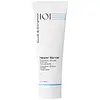What's inside
What's inside
 Key Ingredients
Key Ingredients

 Benefits
Benefits

 Concerns
Concerns

 Ingredients Side-by-side
Ingredients Side-by-side

Water
Skin ConditioningSqualane
EmollientGlycerin
HumectantDicaprylyl Carbonate
EmollientJojoba Oil/Macadamia Seed Oil Esters
Skin ConditioningPolyglyceryl-3 Methylglucose Distearate
EmulsifyingButylene Glycol
HumectantCetearyl Alcohol
EmollientHydroxyethyl Acrylate/Sodium Acryloyldimethyl Taurate Copolymer
Emulsion StabilisingSimmondsia Chinensis Seed Oil
EmollientSaccharide Isomerate
HumectantCamellia Sinensis Leaf Extract
AntimicrobialBisabolol
MaskingAllantoin
Skin ConditioningCeramide Ng
Skin ConditioningSqualene
EmollientPhytosteryl Macadamiate
Skin ConditioningPhytosterols
Skin ConditioningTocopherol
AntioxidantTocopheryl Acetate
AntioxidantCitric Acid
BufferingSodium Citrate
BufferingEthylhexylglycerin
Skin ConditioningPhenoxyethanol
PreservativeWater, Squalane, Glycerin, Dicaprylyl Carbonate, Jojoba Oil/Macadamia Seed Oil Esters, Polyglyceryl-3 Methylglucose Distearate, Butylene Glycol, Cetearyl Alcohol, Hydroxyethyl Acrylate/Sodium Acryloyldimethyl Taurate Copolymer, Simmondsia Chinensis Seed Oil, Saccharide Isomerate, Camellia Sinensis Leaf Extract, Bisabolol, Allantoin, Ceramide Ng, Squalene, Phytosteryl Macadamiate, Phytosterols, Tocopherol, Tocopheryl Acetate, Citric Acid, Sodium Citrate, Ethylhexylglycerin, Phenoxyethanol
Water
Skin ConditioningCaprylic/Capric Triglyceride
MaskingPotassium Cetyl Phosphate
EmulsifyingGlycerin
HumectantLimnanthes Alba Seed Oil
Skin ConditioningPolyglyceryl-3 Polyricinoleate
EmulsifyingSimmondsia Chinensis Seed Oil
EmollientButyrospermum Parkii Butter
Skin ConditioningTheobroma Cacao Seed Butter
EmollientEctoin
Skin ConditioningMaltodextrin
AbsorbentSodium Levulinate
Skin ConditioningGlyceryl Caprylate
EmollientTocopherol
AntioxidantPropanediol
SolventSodium Benzoate
MaskingXanthan Gum
EmulsifyingCitrus Limon Peel Powder
AbsorbentLactobacillus Ferment
Skin ConditioningSodium Phytate
Sodium Stearoyl Lactylate
EmulsifyingCitrus Aurantifolia Peel Powder
Skin ConditioningSclerotium Gum
Emulsion StabilisingTremella Fuciformis Extract
HumectantAvena Sativa Meal Extract
SoothingTapioca Starch
Algin
MaskingGlyceryl Oleate Citrate
EmulsifyingPotassium Sorbate
PreservativeWater, Caprylic/Capric Triglyceride, Potassium Cetyl Phosphate, Glycerin, Limnanthes Alba Seed Oil, Polyglyceryl-3 Polyricinoleate, Simmondsia Chinensis Seed Oil, Butyrospermum Parkii Butter, Theobroma Cacao Seed Butter, Ectoin, Maltodextrin, Sodium Levulinate, Glyceryl Caprylate, Tocopherol, Propanediol, Sodium Benzoate, Xanthan Gum, Citrus Limon Peel Powder, Lactobacillus Ferment, Sodium Phytate, Sodium Stearoyl Lactylate, Citrus Aurantifolia Peel Powder, Sclerotium Gum, Tremella Fuciformis Extract, Avena Sativa Meal Extract, Tapioca Starch, Algin, Glyceryl Oleate Citrate, Potassium Sorbate
 Reviews
Reviews

Ingredients Explained
These ingredients are found in both products.
Ingredients higher up in an ingredient list are typically present in a larger amount.
Glycerin is already naturally found in your skin. It helps moisturize and protect your skin.
A study from 2016 found glycerin to be more effective as a humectant than AHAs and hyaluronic acid.
As a humectant, it helps the skin stay hydrated by pulling moisture to your skin. The low molecular weight of glycerin allows it to pull moisture into the deeper layers of your skin.
Hydrated skin improves your skin barrier; Your skin barrier helps protect against irritants and bacteria.
Glycerin has also been found to have antimicrobial and antiviral properties. Due to these properties, glycerin is often used in wound and burn treatments.
In cosmetics, glycerin is usually derived from plants such as soybean or palm. However, it can also be sourced from animals, such as tallow or animal fat.
This ingredient is organic, colorless, odorless, and non-toxic.
Glycerin is the name for this ingredient in American English. British English uses Glycerol/Glycerine.
Learn more about GlycerinThis oil comes from the seeds of the desert shrub called Jojoba. It is more commonly known as jojoba oil, a non-comedogenic oil.
Jojoba oil does not contain fragrance and has many fatty-acids, making it a great soothing ingredient.
It also contains Vitamin E, a great moisturizing ingredient. Vitamin E is also an antioxidant and protects your skin against oxidative damage.
This ingredient humectant properties, meaning it helps draw moisture from the air. This helps keep your skin hydrated.
While jojoba has antibacterial properties, it is only able to kill some strains of bacteria.
Studies also show it helps in wound healing. In fact, Indigenous cultures have used jojoba as a moisturizer and to help treat burns for centuries.
Fun fact: Jojoba oil similar to natural human skin sebum, so it has a great effect on dry skin. It is also promising with helping to regulate sebum production.
Due to its fatty acid content, Jojoba oil may not be fungal acne safe. We recommend speaking with a professional if you have any concerns.
Learn more about Simmondsia Chinensis Seed OilTocopherol (also known as Vitamin E) is a common antioxidant used to help protect the skin from free-radicals and strengthen the skin barrier. It's also fat soluble - this means our skin is great at absorbing it.
Vitamin E also helps keep your natural skin lipids healthy. Your lipid skin barrier naturally consists of lipids, ceramides, and fatty acids. Vitamin E offers extra protection for your skin’s lipid barrier, keeping your skin healthy and nourished.
Another benefit is a bit of UV protection. Vitamin E helps reduce the damage caused by UVB rays. (It should not replace your sunscreen). Combining it with Vitamin C can decrease sunburned cells and hyperpigmentation after UV exposure.
You might have noticed Vitamin E + C often paired together. This is because it is great at stabilizing Vitamin C. Using the two together helps increase the effectiveness of both ingredients.
There are often claims that Vitamin E can reduce/prevent scarring, but these claims haven't been confirmed by scientific research.
Learn more about TocopherolWater. It's the most common cosmetic ingredient of all. You'll usually see it at the top of ingredient lists, meaning that it makes up the largest part of the product.
So why is it so popular? Water most often acts as a solvent - this means that it helps dissolve other ingredients into the formulation.
You'll also recognize water as that liquid we all need to stay alive. If you see this, drink a glass of water. Stay hydrated!
Learn more about Water